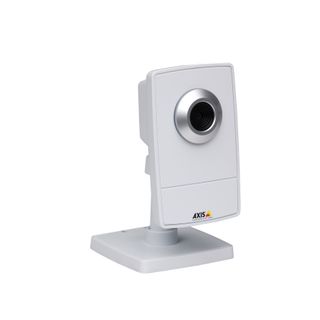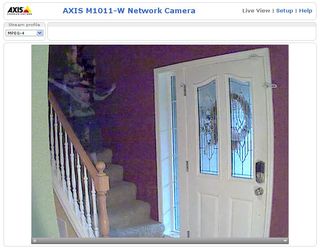PC-Based Home Security: Do It Yourself
We test products that let you monitor and protect your home without the need for an outside security company's services: D-Link, Axis, Logitech, Schlage
Axis M1011-W
Unlike D-Link, which tends to cover anything and everything in the world of networking, Axis specializes in network video. The assumption is that this specialization yields higher quality products, but does it also yield higher total value? It’s a given that Axis will cost more than D-Link, but do you get more bang for the security buck? Let’s find out.
The M1011-W is billed as Axis’s “smallest wireless network camera from the market leader.” With dimensions of only 1.1” x 2.3” x 3.7”, the camera measures almost identically against D-Link’s DCS-930L. The striking difference between the two is that Axis is still using 802.11b/g wireless networking. Given my past experience with streaming video over 802.11g, this does not fill me with joy heading into testing. However, Axis seems to compensate for the slower bandwidth with increased buffering. Using the default Motion JPEG mode, images seem to lag behind reality by about one-half to one second. Stepping up to H.264 streaming, that lag jumps to about three seconds. It also helps that, like the 930L, the M1011-W has a top resolution of 640 x 480, so it’s not like you’re trying to stream HDTV.

There are several small ways in which Axis differentiates the M1011-W from its D-Link peer. One of my favorites is the ring of LED light around the fixed focus lens, which glows yellow or green depending on the camera status. It’s a small, classy-looking touch that says, “Hey, there’s a surveillance camera watching you,” and you can disable it in the camera settings. More importantly, the M1011-W supports simultaneous, multiple H.264 streaming, with each stream having its own quality/bandwidth parameters. In general, H.264 is the highest quality stream type you’ll find on today’s network cams. Axis also allows for HTTPS encryption so outsiders can’t hack your video streams.
In terms of image quality, the image below tells us several things about the M1011-W.

This shot was captured in mid-afternoon on an overcast day with a lamp on the floor just out of view for additional illumination. The Axis camera does a much better job than D-Link at bringing out shadowy areas, but there’s a price to be paid in graininess. You can clearly see the compression noise and color blotchiness on that dark red wall, and that’s using an MPEG-4 stream, which is higher quality than MJPEG.
More importantly, you can see that the boy moving through the image has had the top part of his body obscured by blocking artifacts. I saw this happen repeatedly with moving elements within Axis scenes, and it’s the result of 802.11g’s bandwidth limitations. This simply never happened with the D-Link cameras. To be fair, the effect is fleeting, lasting only a second, but if you’re trying to capture a thief in action, a second of footage might be all you get. This noise and artifacting was greatly reduced when using H.264 streams. In fact, the difference between these codecs is so obvious that Axis might consider simply eliminating the MPEG-4 mode in the future, as it did with our next camera, the Axis M1054.
\
Sign up to get the BEST of Tom's Guide direct to your inbox.
Get instant access to breaking news, the hottest reviews, great deals and helpful tips.
Current page: Axis M1011-W
Prev Page D-Link DCS-930L mydlink-Enabled Wireless N Network Camera Next Page Axis M1054William Van Winkle is a freelance editor and tech journalist who has been writing for more than 20 years. His work has appeared on Tom's Guide, Tom's Hardware, Tom's IT Pro, AMD, Seagate, Computer Shopper, and more. He is also an author, writing poetry, short stories, and science fiction and fantasy books.
-
thegreathuntingdolphin William,Reply
Cool article. I have been looking into security cameras for the home, especially ones that are outdoor or pointed outdoor (some noobcakes have been hitting cars and driving off in my apartment complex). I am a bit dissapointed that most of these don't really seem good for outdoors or for long distance night recording (I know some of these said up to 20 to 30 feet but in my experience that means they are really only clear at 10-15 feet). Foscam has a number of cheap IP cameras with pan and tilt, are for outdoor use or longer night vision use. Do you have any experience with them?
The Schlage system is looking good. Hopefully others will jump on the bandwagon and get more products out. I am glad the Schlage deadbolt is not motorized like the Kwikset one since it greatly improves the battery life. Whenever I get a house I am definitly going to do something like the LiNK system.
I too am disappointed in the current IP-based offerings. The perfect IP-based camera seems illusive. Too many have half the features. Most the N wireless ones seems to lack really good night vision capabilities and the ones with good night vision capabilities usually are G only or have N are stupidly expensive. -
Nice article!Reply
It’s interesting how IP cameras and emerging technology, such as Jabbakam.com enable average people to transform a home surveillance system into a shared camera network that can be accessed by whoever is invited by the camera owners, to view the footage via an online account accessible from anywhere at anytime.
Jabbakam is a system where you have complete access to your footage, to manage and share as you want. You can easily create a network (public or private) and invite your friends or neighbours to join and add their cameras so that you all have access to the footage of the cameras as a group.
You can set up alerts so that you will be notified by email or sms if your camera detects something happening in front of it, and you have peace of mind that your camera is doing its job and working, thanks to a monitoring system that checks your camera status every few minutes. The Jabbakam website offers users a lot more functionality besides. Check us out, and join us on Facebook.com/jabbakam and Twitter (@jabbakam). We’d love to hear from you! -
It is still an annual subscription of $80 a year it is only very well hidden by Logitech (just try and buy it and you will figure it out).Reply
The hiding of subscription cost itself is terrible, but also that they sell you just part of a product is outragous. It makes me mad and takes some of the joy of owning such a cool (and expensive) product. -
I'll never buy a product that requires a subscription or is dependent on another site or "the cloud". Excellent article, except for the WPS thing.. WTH is that?Reply
